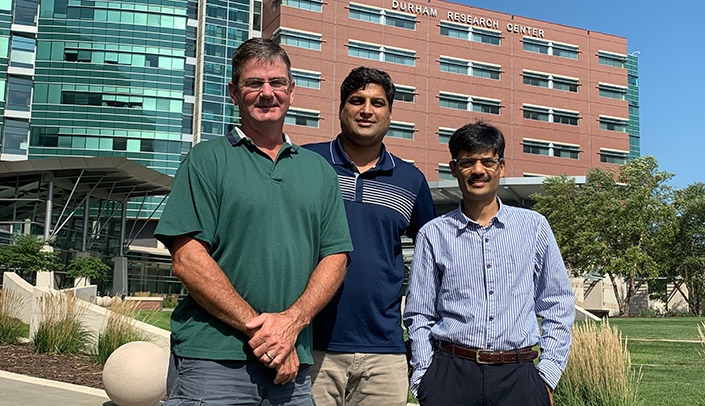UNMC’s talented gene editing team led by Channabasavaiah Gurumurthy, Ph.D., and his research associates, Donald Harms and Rolen Quadros, is at it again.
Using CRISPR gene editing technology, the UNMC team developed a specially engineered mouse for two Stanford University scientists, Natalia Gomez-Ospina, M.D., Ph.D., and Matthew Porteus, M.D, Ph.D. The research, which was published in Nature Communications, demonstrated how CRISPR genome-edited blood stem cells and mice can help treat complex childhood diseases such as mucopolysaccharidosis type 1.
In humans and mice, if the enzyme iduronidase is lacking, it can lead to devastating neurological, skeletal and visceral problems. These diseases inflict terrible suffering as they typically present in healthy children followed by relentless decline, and are often lethal.
The Stanford team inserted a copy of the enzyme-producing gene into human blood stem cells using the CRISPR technology to make those cells produce more of the missing enzyme. These “engineered human cells” were then transplanted into the gene-edited mice (created by the UNMC team) where the human cells provided the enzyme needed to correct the symptoms.
“The strategy demonstrated in our study could be a one-time therapy for the disease, and it is safer and likely more effective than current treatment options,” Dr. Gomez-Ospina said. “The other great thing about this work is that it is easily adaptable to other lysosomal storage diseases.”
Dr. Porteus became aware of the CRISPR technical capabilities of Dr. Gurumurthy’s laboratory when the two scientists met at a conference in Boston in 2015. Dr. Porteus then tasked Dr. Gurumurthy with the challenge of creating the mouse model under the special strain, which then led to the collaboration.
“This work needed a gene-edited model in a mouse strain having immunodeficient status, because human cells needed to be transplanted into mice for the critical experiments. The experiments would not work if the mice strain was non-immunodeficient,” Dr. Gurumurthy said. “Developing models in such special strains was nearly impossible before the CRISPR era, because the previous technologies were mainly possible in just one or two standard mouse strains.”

Congratulations Rolen!
Thanks for all the great work Guru, Rolen, and Don. It's exciting to see the rapid progress of your techniques and how quickly they can become translational. Hoping for many miracle cures in the future based on the science you've developed.
Congratulations
Congratulations! Another great example of UNMC researchers making an impact.